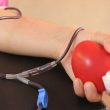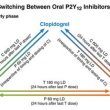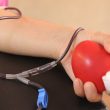In the subgroup of patients with ST-segment elevation myocardial infarction who fail thrombolysis, transradial access reduces both bleeding and mortality, according to the results of this new study recently published in JACC Cardiovascular Interventions. Overall, transradial access following failed thrombolysis was associated with a 70% reduction in vascular complications, a 28% reduction in combined in-hospital<a href="https://solaci.org/en/2017/12/07/arterial-access-after-thrombolysis/" title="Read more" >...</a>
Patients and Healthcare Providers Benefit from Less Symptoms and Lower Costs with FFR
Previous studies in which revascularization was guided by angiography alone found that coronary angioplasty does not improve outcomes compared with optimal medical treatment in patients with chronic stable angina. The FAME 2 trial (Fractional Flow Reserve Versus Angiography for Multivessel Evaluation) compared angioplasty guided by fractional flow reserve (FFR) with optimal medical treatment, arriving to<a href="https://solaci.org/en/2017/12/05/patients-and-healthcare-providers-benefit-from-less-symptoms-and-lower-costs-with-ffr/" title="Read more" >...</a>
Non-Invasive FFR: CT Evolves from Anatomical to Functional
In the US, more than 4 million patients with chronic stable angina are looking to rule out heart disease. Most undergo functional diagnostic studies that might lead to invasive coronary angiography followed by revascularization. CT has become an alternative diagnostic tool thanks to its precision to rule out heart disease (negative predictive value between 97<a href="https://solaci.org/en/2017/12/01/non-invasive-ffr-ct-evolves-from-anatomical-to-functional/" title="Read more" >...</a>
Radiation Exposure in Chronic Total Occlusions
Even in the hands of experienced operators, rechanneling and angioplasty of a chronic total occlusion (CTO) results in patients and the whole cath lab team receiving high doses of radiation, according to this registry presented at the American Heart Association 2017 Scientific Sessions. Up to 23% of patients who undergo rechanneling of a CTO receive<a href="https://solaci.org/en/2017/12/01/radiation-exposure-in-chronic-total-occlusions/" title="Read more" >...</a>
When and How to Switch Dual Antiplatelet Therapies
Dual antiplatelet therapy with aspirin and a P2Y12 inhibitor is the treatment of choice for patients with acute coronary syndrome who undergo coronary angioplasty. Different oral P2Y12 inhibitors (clopidogrel, prasugrel, ticagrelor) present different characteristics as regards efficacy, risk for bleeding, cost, and timing of administration. In this sense, physicians frequently switch among drugs according to<a href="https://solaci.org/en/2017/11/27/when-and-how-to-switch-dual-antiplatelet-therapies/" title="Read more" >...</a>
Latest articles about peripheral vascular diseases
1) Efficacy of Micromesh-Covered Stents in Carotid Artery Stenting Most literature, old and recent, associates carotid artery stenting with a higher rate of stroke (although minor) when compared with carotid endarterectomy during the acute period. However, 30-day outcomes of angioplasty and surgery are comparable. Read more 2) Multivessel Disease and Severe Carotid Stenosis: How to Proceed Myocardial revascularization surgery (CABG) is<a href="https://solaci.org/en/2017/11/22/latest-articles-about-peripheral-vascular-diseases/" title="Read more" >...</a>
DKCRUSH-V: Left Main, Not Just Another Bifurcation
Cardiac Artery Bypass Graft Surgery has been shown more effective than percutaneous coronary intervention (basically because it renders lower revascularization rate) in patients with severe left main bifurcation lesions receiving 1st generation drug eluting stents. This is why the 2014 American guidelines recommend CABG for most patients. But the EXCEL and the NOBLE trials brought back hope to<a href="https://solaci.org/en/2017/11/22/dkcrush-v-left-main-not-just-another-bifurcation/" title="Read more" >...</a>
DACAB: Ticagrelor and Aspirin Improve Vein Graft Patency
According to this Chinese study, dual antiplatelet therapy with ticagrelor and aspirin improves vein graft patency a year after surgery without increasing the risk for major bleeding. Treatment with the P2Y12 inhibitor ticagrelor in combination with aspirin has been widely accepted for patients with acute coronary syndrome undergoing angioplasty. However, there were no related data regarding surgical revascularization. Read also: “Ticagrelor<a href="https://solaci.org/en/2017/11/16/dacab-ticagrelor-and-aspirin-improve-vein-graft-patency/" title="Read more" >...</a>
NCDR ACTION Registry: Anticoagulated Patients with No Higher Risk of Bleeding in Emergency Procedures
Patients with a history of atrial fibrillation treated with warfarin or any of the new direct oral anticoagulants undergoing acute myocardial infarction do not present higher risk of bleeding when receiving angiography or angioplasty. In fact, this subgroup of anticoagulated patients showed lower in-hospital mortality than the control group. After analyzing 6471 patients undergoing ST elevation MI<a href="https://solaci.org/en/2017/11/16/ncdr-action-registry-anticoagulated-patients-with-no-higher-risk-of-bleeding-in-emergency-procedures/" title="Read more" >...</a>
Though on the Rise, the Transradial Approach to Primary PCI Remains Underused
There is evidence to support the use of the transradial approach to coronary angioplasty. Several randomized studies have shown reduced bleeding and vascular complications when adopted, compared against patients treated with the femoral approach. There are also studies and meta-analysis suggesting that, in the context of primary PCI, the benefit would be even bigger, with significant events<a href="https://solaci.org/en/2017/11/10/though-on-the-rise-the-transradial-approach-to-primary-pci-remains-underused/" title="Read more" >...</a>









